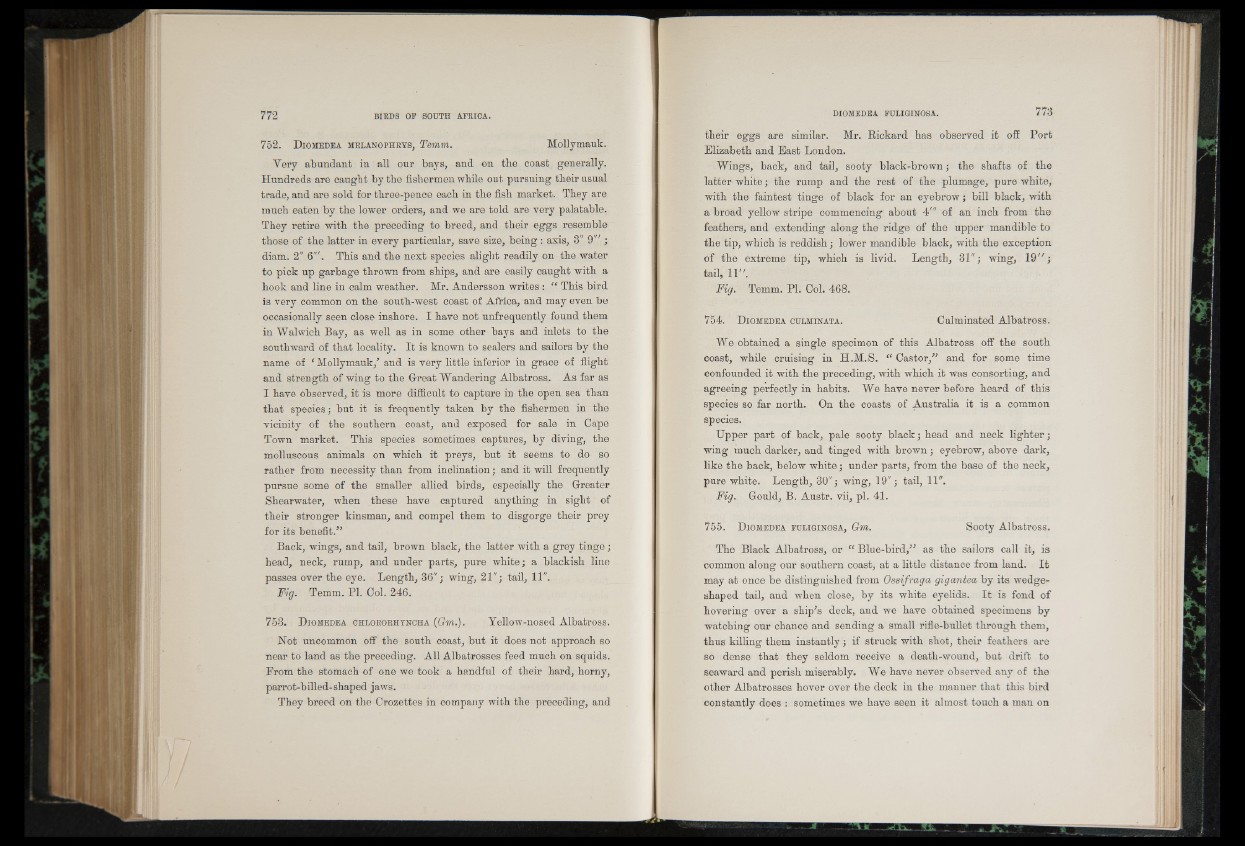
752. D iomedea melanophrys, Temm. Mollymauk.
Very abundant in all our bays, and on tbe coast generally.
Hundreds are caugbt by tbe fishermen while out pursuing their usual
trade, and are sold for three-pence each in the fish market. They are
much eaten by the lower orders, and we are told are very palatable.
They retire with the preceding to breed, and their eggs resemble
those of the latter in every particular, save size, being: axis, 3" 9"/ ;
diam. 2" 6'". This and the next species alight readily on the water
to pick up garbage thrown from ships, and are easily caught with a
hook and line in calm weather. Mr. Andersson writes : “ This bird
is very common on the south-west coast of Africa, and may even be
occasionally seen close inshore. I have not unfrequently found them
in Walwich Bay, as well as in some other bays and inlets to the
southward of that locality. It is known to sealers and sailors by the
name of 'Mollymauk/ and is very little inferior in grace of flight
and strength of wing to the Great Wandering Albatross.. As far as
I have observed, it is more difficult to capture in the open sea than
that species j but it is frequently taken by the fishermen in the
vicinity of the southern coast, and exposed for sale in Cape
Town market. This species sometimes captures, by diving, the
molluscous animals on which it preys, but it seems to do so
rather from necessity than from inclination; and it will frequently
pursue some of the smaller allied birds, especially the Greater
Shearwater, when these have captured anything in sight of
their stronger kinsman, and compel them to disgorge their prey
for its benefit.”
Back, wings, and tail, brown black, the latter with a grey tinge;
head, neck, rump, and under parts, pure white; a blackish line
passes over the eye. Length, 36"; wing, 21"; tail, 11".
Fig. Temm. PI. Col. 246.
753. D iomedea chlororhyncha (Gm.). Yellow-nosed Albatross.
Not uncommon off the south coast, but it does not approach so
near to land as the preceding. All Albatrosses feed much on squids.
From the stomach of one we took a handful of their hard, horny,
parrot-billed-shaped jaws.
They breed on the Crozettes in company with the preceding, and
their eggs are similar. Mr. Rickard has observed it off Port
Elizabeth and East London.
Wings, back, and tail, sooty black-brown; the shafts of the
latter white; the rump and the rest of the plumage, pure white,
with the faintest tinge of black for an eyebrow; bill black, with
a broad yellow stripe commencing about 4'" of an inch from the
feathers, and extending along the ridge of the upper mandible to
the tip, which is reddish; lower mandible black, with the exception
of the extreme tip, which is livid. Length, 31"; wing, 19” ;
tail, 1 1 ”.
Fig. Temm. PI. Col. 468.
754. D iomedea culminata. Culminated Albatross.
We obtained a single specimon of this Albatross off the south
coast, while cruising in H.M.S. “ Castor,” and for some time
confounded it with the preceding, with which it was consorting, and
agreeing perfectly in habits. We have never before heard of this
species so far north. On the coasts of Australia it is a common
species.
Upper part of back, pale sooty black; head and neck lighter;
wing much darker, and tinged with brown; eyebrow, above dark,
like the back, below white; under parts, from the base of the neck,
pure white. Length, 30"; wing, 19"; tail, 11".
Fig. Gould, B. Austr. vii, pi. 41.
755. D iomedea ful iqin o sa , Gm. Sooty Albatross.
The Black Albatross, or “ Blue-bird,” as the sailors call it, is
common along our southern coast, at a little distance from land. It
may at once be distinguished from Ossifraga gigantea by its wedge-
shaped tail, and when close, by its white eyelids. I t is fond of
hovering over a ship's deck, and we have obtained specimens by
watching our chance and sending a small rifle-bullet through them,
thus killing them instantly; if struck with shot, their feathers are
so dense that they seldom receive a death-wound, but drift to
seaward and perish miserably. We have never observed any of the
other Albatrosses hover over the deck in the manner that this bird
constantly does : sometimes we have seen it almost touch a man on